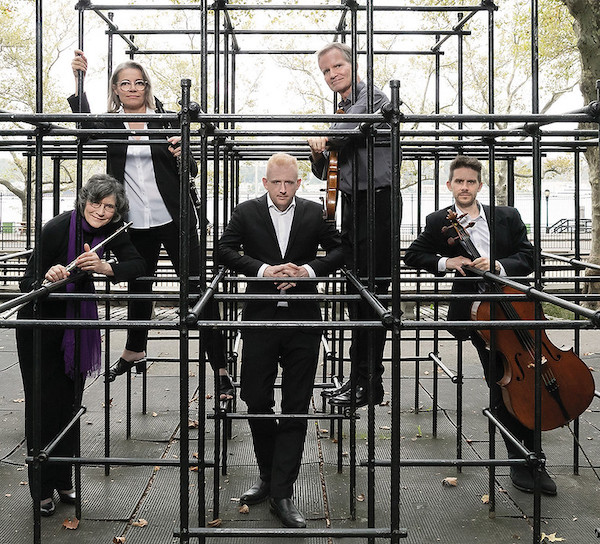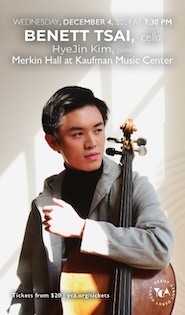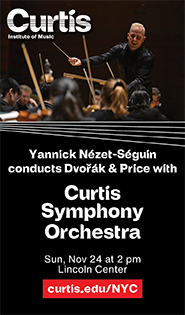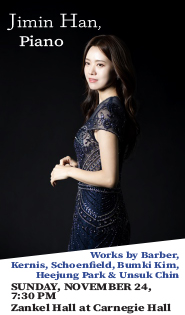Da Capo Chamber Players mix it up with composers past and present

The Da Capo Chamber Players opened their 51st season with a program entitled “Juxtapositions” Sunday evening at the Tenri Cultural Institute. Renowned for penetrating and polished performances, Da Capo has been crucial in creating a body of contemporary American chamber music by commissioning over 100 new works. Through their performances, they have introduced this repertoire to audiences around the world.
Da Capo is comprised of flutist Patricia Spencer, violinist Curtis Macomber, clarinetist Marianne Gythfeldt, cellist Chris Gross, and pianist Steve Beck. Gross was ill and replaced on two-days notice by Michael Nicolas. For this concert, the ensemble was joined by violist Lois Martin, flutist Yoshi Weinberg, and conductor James Baker.
The works on the program spanned the years 1979 to 2006. They represent the mix of established composers with whom Da Capo has worked with for decades as well as composers of a younger generation who invigorate today’s new music scene.
Da Capo’s passion for present-day composers and their music extends to cultivating musicians who will perform it. The mix of original or long-standing members of the ensemble performing alongside a younger generation of artists, such as Beck, Nicolas and Weinberg, help to ensure that Da Capo’s mission will continue, as well as adding a certain frisson to the performances.
A fascinating element of the program was a juxtaposition of still yet another sort. Charles Wuorinen refused to reveal the meaning of a work. In many ways, Mario Davidovsky was cut from the same cloth. They insisted that their music speaks for itself.
Da Capo, however, performed Wuorinen’s Trio for Violin, Cello and Piano and Davidovsky’s Quartetto No. 4 alongside works by composers who expressly intended to evoke images or convey the impression of events in their music. Philosophy aside, however, it was obvious that the goal of all six composers was to create sounds that stir the imagination and invoke an emotional response.
In First Lines, Amy Williams describes in music a brief line of poetry. Scored for flute and piano, each of the work’s eleven short movements are preceded by the reading of a brief line of poetry. Weinberg and Beck alternated reciting the bits of poetry. With their words and their playing, they were adept at capturing the atmospheric qualities of William’s music, as well as its wit. No sooner were the words “Hush, my mother is sleeping…” spoken, than a crashing chord prompted laughter from the audience. It ends with slow, rhythmic breathing sounds played by the flute.
Robert Martin is a composer who focuses on ideas, images, and gestures. His single-movement work Nighttime is a nocturne that takes the listener from a fireside at twilight to the the first rays of morning light. Scored for flute, clarinet, violin, cello and piano, Martin is a master of depicting images as subtle and fleeting as the buzz of an insect to a crackling fire.
Lei Liang’s Gobi Canticle grew out of his admiration for Mongolian music. It was inspired by Xu Ke’s Gobi Polyphony, as well as traditional Mongolian chants, dances, and folk songs. Violinist Macomber and cellist Nicholas engaged in an absorbing dialogue as they wended their way through Lei Liang’s beguiling and melodious music.
The final work on the program was Jason Eckardt’s After Serra. His music reflects his interests in perceptual complexity, psychological and physical dimensions of performance, and self-organizing processes in the natural world.
The work of American artist Richard Serra was the inspiration for After Serra, composed for bass flute, bass clarinet, violin, cello and piano. Eckardt didn’t seek to depict Serra’s large-scale sculptures through music, but rather “to convey in sound the simultaneous imposition and precariousness that I perceive in his pieces.”
This instability was vividly captured in a performance led by conductor James Baker. The music teetered between frenetic energy and repose. The former was provided by piano and strings, which was countered by softer, transparent, and calmer passages for the flute or clarinet.
The work ends quietly, with the bass clarinet, violin, and cellos sustaining a perfect, pure dissonance that spanned octaves. Beautiful as it was, Eckardt left nothing resolved, only an uneasiness that chaos could erupt at a moment’s notice.
The Da Capo Chamber Players present “Women and Jazz,” 8 p.m., Sunday, February 26, 2023. dacapochamberplayers.org



